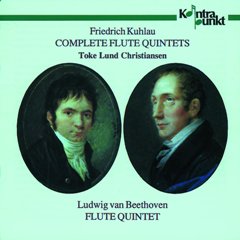Kuhlau – Complete Flute Quintets (1993)
Kuhlau – Complete Flute Quintets (1993)

CD1 Quintet for flute, violin, 2 violas & cello in A major, Op. 51/3 01. Allegro con fuoco [0:13:15.23] 02. Scherzo. Allegro assai quasi presto [0:04:28.65] 03. Adagio ma non troppo [0:07:28.32] 04. Finale. Vivace [0:04:45.53] Quintet for flute, violin, 2 violas & cello in D major, Op. 51/1 05. Allegro [0:11:43.17] 06. Menuetto. Allegro con spirito [0:04:44.58] 07. Adagio ma non troppo [0:08:17.55] 08. Finale. Allegro assai [0:07:16.55] CD2 Quintet for flute, violin, 2 violas & cello in E major, Op. 51/2 01. Adagio ma non troppo [0:15:02.25] 02. Menuetto [0:05:01.00] 03. Andante [0:07:05.33] 04. Finale. Allegro [0:07:56.45] Beethoven - Sonata for violin & piano No. 8 in G major, Op. 30/3 05. Allegro assai [0:07:06.65] 06. Tempo di Minuetto [0:09:49.32] 07. Allegro vivace [0:03:44.53] Toke Lund Christiansen (Flute) Johannes Soe Hansen (Violin) Michael Dolgin, Henrik Olsen (Viola) Troels Svane Hermansen (Cello)
Friedrich Kuhlau (1786-1832) was a Danish composer active during the late Classical and early Romantic periods. Mozart, Spohr and Weber all had a great influence on his music, but no composer did so much as Beethoven, whom Kulau idolized. He used his prominence in the Copenhagen music scene to grow an audience for Beethoven's music in Denmark. One of his first great successes was the Piano Concerto in C major, Op. 7, modeled so closely on Beethoven's First Piano Concerto as to practically be a pastiche.
Aside from his compositions for solo piano (which hold a firm place in the instrument's pedagogy as well as the repertoire) and the stage works he composed for the Dansh National Opera, Kuhlau's most important area of output was chamber music. He had a firm grasp of the technical and expressive qualities of the flute, an instrument appearing in more than sixty of his chamber works. In the three flute quintets of opus 51 heard on this recording, the quartet of string players is rather uncommonly scored for one violin with two violas and a cello. This instrumentation is indicative of Kuhlau's intention that the flute be not so much a solo instrument in these settings as a member of the ensemble, very much taking on the role of a first violin. At the bottom of the spectrum, the two violas with cello lend a rich, resonant timbre to the body of sound. ---brilliantclassics.com
download (mp3 @320 kbs):
yandex mediafire ulozto bayfiles








